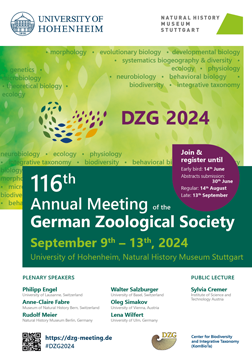
Jenna Moore
Museum of Nature Hamburg, Zoology
Leibniz Institute for the Analysis of Biodiversity Change
Germany
How the fairy tube-worm got its dance, and other evolutionary tales of form and function in marine annelids
Marine annelids are amazingly morphologically diverse, reflecting both the flexibility of their segmented body plan, which has allowed them to radiate into every marine habitat, and their diverse feeding strategies—including suspension feeding, detritivory, herbivory, and predation. Tagmatization is the functional specialization of groups of body segments and a defining feature of arthropods. However, functional body regionalization is not as well understood in annelids, another major lineage of segmented animals. This talk will explore functional morphological evolution in two distantly related clades of marine annelids. I will present results on the evolution of tagmatization in Chaetopteridae, a small group of tube-dwelling annelids. Their diverse and flexible feeding modes provide a unique natural experiment to explore body region specialization in annelids in phylogenomic context. I will discuss how a complete organismal view, linking phylogeny, form, function, ecology, and oceanography, can inform systematics and taxonomy. I will also present ongoing research on the evolution of complex jaw structures in Eunicida, a diverse lineage of marine annelids with a rich fossil record from the late Cambrian to the Recent. Eunicidans have diverse, complex, articulated jaw structures, and lifestyles ranging from tiny microphagous worms to the giant “sand-striker” worm, an ambush predator of fish. Both examples will illustrate how museum collections can be used to investigate functional morphological evolution, generate new character information for systematics and taxonomy, and provide context for global biogeographic patterns by revealing evolutionary constraints and opportunities.
Francisco J. Ruiz-Ruano
Leibniz Institute for the Analysis of Biodiversity Change (LIB)
Museum Koenig (ZFMK), Bonn
Germany
Diversity of the germline-restricted chromosome in passerines birds
The genomics field has significantly advanced our understanding of avian chromosome evolution. However, a special chromosome consistently found across all studied songbird species has been scarcely considered in the genomic research. This is a germline-restricted chromosome (GRC) which is absent in the somatic line and only present in the germline.
The recent works in the zebra finch, two nightingales and the blue tit have suggested a shared ancestral origin for songbird GRCs. These chromosomes exhibit an exceptional rate of content turnover compared to the rest of the genome. Here, we aim to explore the biodiversity of GRCs across the passerine phylogeny. Using linked-read libraries from 10x Genomics Chromium, we sequenced draft genomes from both germline and soma tissues of 25 species within the Estrildidae family and other Passeriformes families, including two suboscines as well. Also, we went deep in two species by performing testis long-read assemblies. Our comparative analysis revealed that the GRC was present in a common ancestor of all passerines, so two thirds of all bird species would carry it.
Additionally, we found a remarkable diversity in the GRC led by expansion and contraction of repeats as well as events of gene acquisition and loss. Actually, only a few genes are ancient and widespread like elavl4, cpeb1, bicc1 and pim1, raising the possibility that they are important for the function of this mysterious chromosome.



